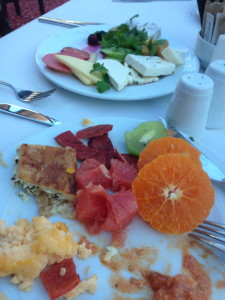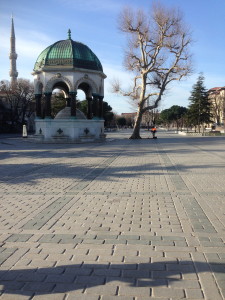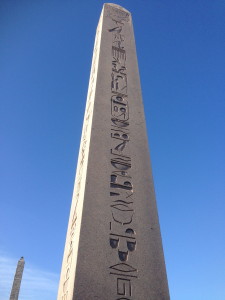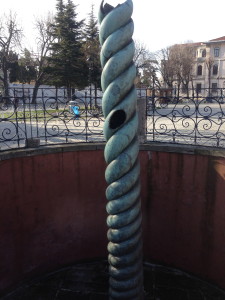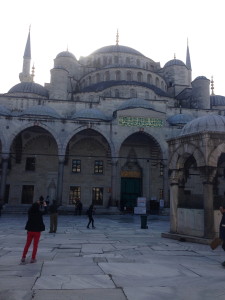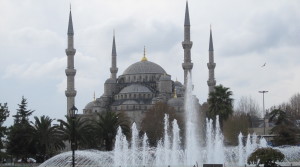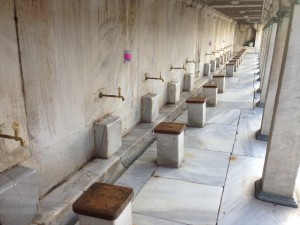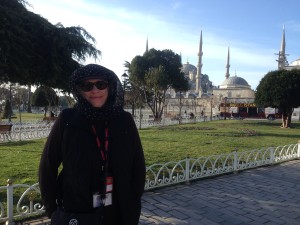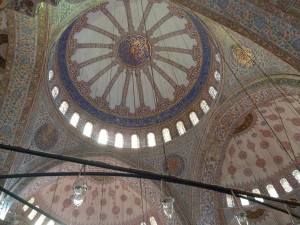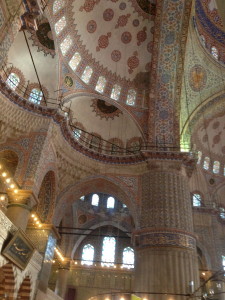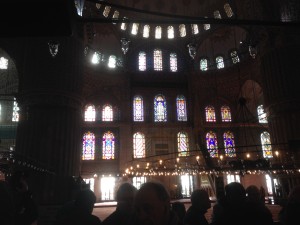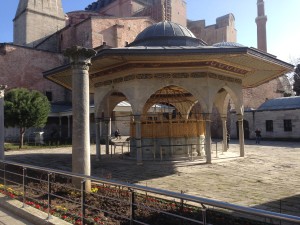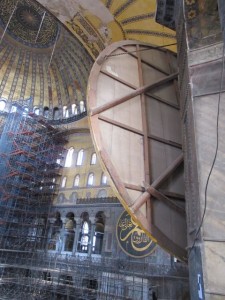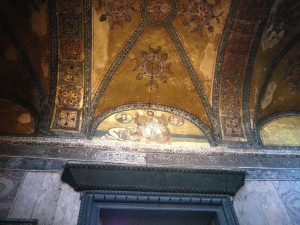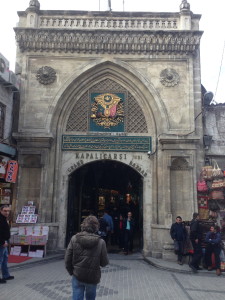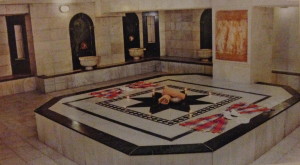I woke to the 5:30 am call to prayers from a mosque just down the street, the voice a deep, sonorous ululation picked up and echoed from the top of minarets across the city. I lay in bed listening to the ancient cry, imagining a time when a man rather than a loud speaker called from each minaret. The call lasted only four or five minutes, but even as the closet voice fell silent, the calls continued from distant minarets, dying out one by one, leaving only the cries, barks, and laughs of the ubiquitous seagulls that fly over this city of fifteen million. They fly by outside the window like white ghosts, their bodies lit from the light of the streets below, white against the blue black sky.
Breakfast this morning was fit for an Ottoman sultan: a half a dozen different kinds of olives, cheeses, meats, nuts, fresh and dried fruits, yogurt, oatmeal, delicious Turkish coffee, juices, pastries and an entire buffet of hot options, eggs (scrambled, soft and hard boiled) spicy stewed vegetables, a spicy cheese and tomato dish, and numerous Turkish sausage selections all served with a view of the ferries busily plying the Bosphorous below.
Our bus dropped us at Taksim Square, and our guide, Serder, walked us through the hippodrome, which sat 100 thousand people and was used for chariot races in Roman times, (apparently, racing chariots was more dangerous than being a gladiator).
The Romans decorated the hippodrome with monuments from their far-flung empire—an obelisk from Karnak in Egypt dating from 1489 BC was shipped and unfortunately broken, so it is 1/3 shorter than it was originally.
A second monument, the column of three snakes, was built from the melted down armor of the Persians defeated by Alexander the Great’s father.
When Ottomans took over in 1153, they had no use for chariot racing , removed the seats, and made the hippodrome into a horse trading market. The third monument, the Column of Constantine was originally covered in bronze, but was stripped by the retreating Crusaders who occupied the city from 1313 to 1364 and used the bronze to make coins. The Crusaders looted the city when they left, taking among other things the 3 bronze horses that sit atop St Marks Cathedral in Venice.
Outside the Blue Mosque there are rows of ablution faucets.
In the past, Muslims were required to wash their legs from the knees down, their hands, and their faces because few homes had running water. Before entering women must cover their heads with scarves (available outside if you don’t have one) and everyone must remove his/her shoes (plastic bags provided to carry your shoes).
The name Blue Mosque comes from the color of the interior tiles, twenty-five thousand of them, depicting floral motifs
symbolic of heaven.
The stained glass in the windows was imported from Venice.
The Blue Mosque is the only mosque in Turkey with six minarets, which make it seem larger to compete with Hagia Sophia. The six minarets put it in competition with Mecca, an issue resolved only when Mecca added a seventh minaret.
Hagia Sophia, which means holy wisdom in Greek, was built in a remarkably short five years (for what today would be 2.5 billion dollars) under Emperor Justinian. It is the first domed church and the 3rd largest Christian church in the world.
When the Turks took over, it was converted into a mosque, and the mosaics depicting figures were plastered over (because Islam forbids the depiction of people as competition with the creator). 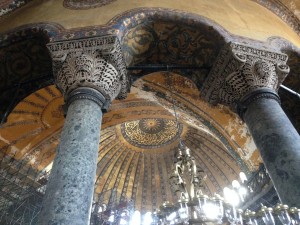
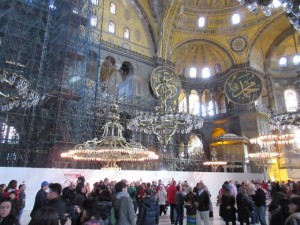
The Turks also added the immense oil lamps (now electrified) and huge round icons painted with holy sayings. They are made of camel skin over wooden frames.
In 1923, when Turkey became a republic, Hagia Sophia was turned into a museum and the mosaics are slowly being uncovered and restored.
In the afternoon, we left our group and ventured off the Grand Bazaar, where we wandered through Byzantine maze of stalls and shops and shopped til we dropped, purchasing some gorgeous Turkish ceramic bowls and silver jewelry.
By the time we made it back to the hotel, we had walked over 7.5 miles. Ellie painted a pastel of the rooftop scene from our window while I went down to the hamam in the basement of the hotel, complete with sauna and marble hamam (octagonal heated marble platform surrounded by spigots and basins for rinsing off when you have soaped yourself down).
I emerged relaxed but still weary. We ventured out for a bite to eat in a gyro dive overlooking the street, the perfect meal for two exhausted, still jet-lagged travelers. It’s an early night tonight and a 7:45 departure for Anzac Cemetery and the Dardanelles in the morning.




